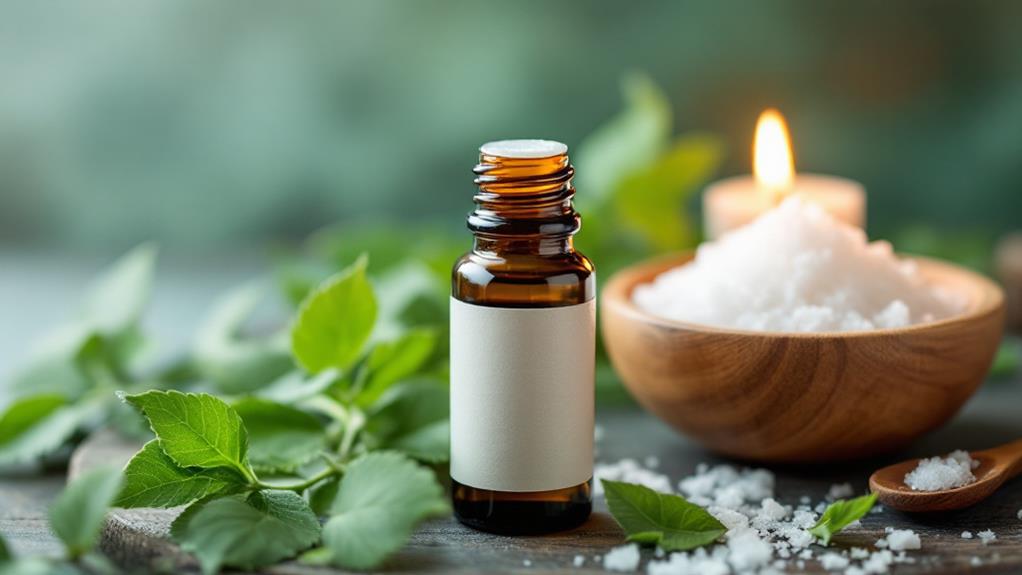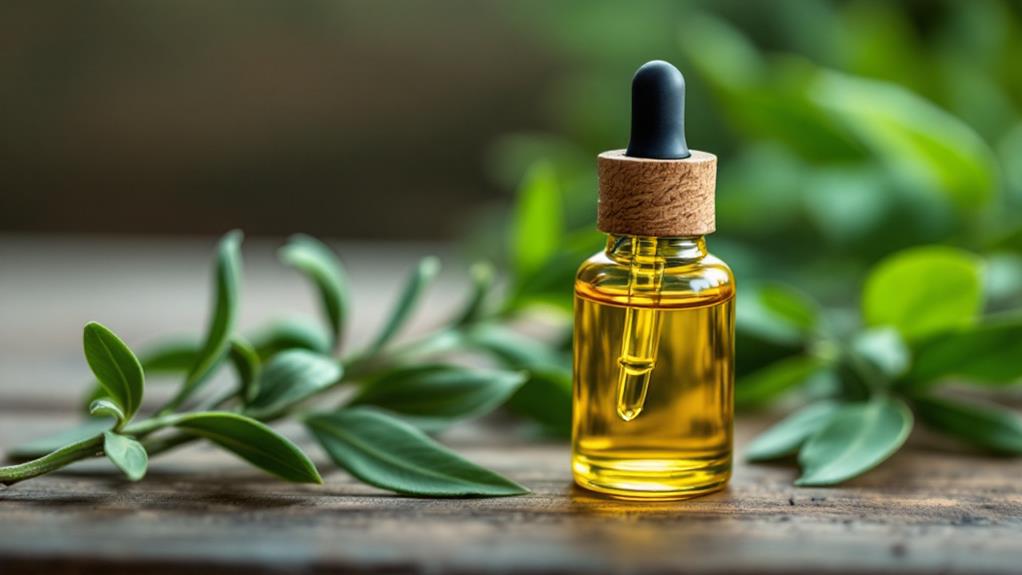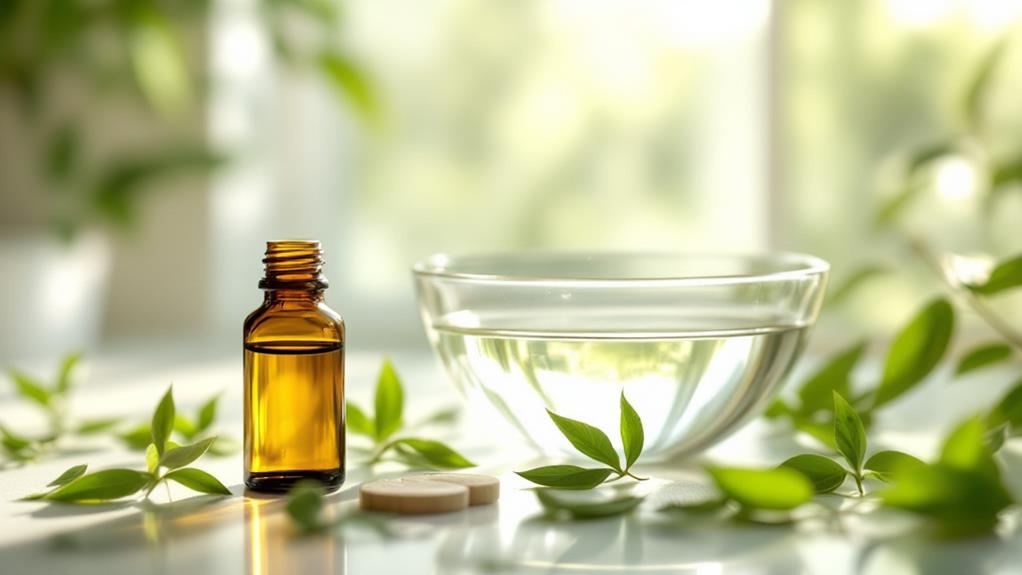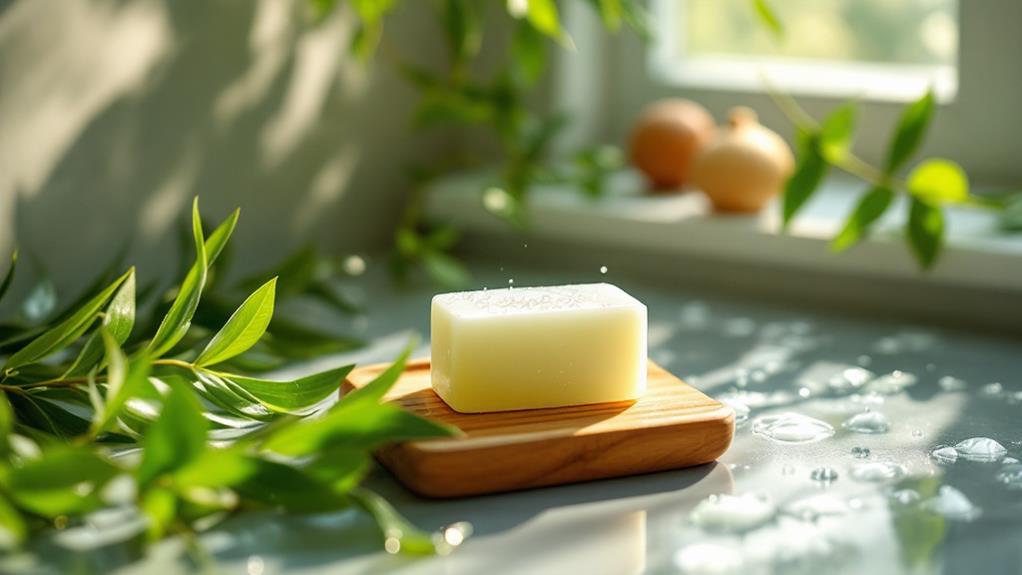How Is Tea Tree Oil Made? The Process Behind This Natural Remedy

To make tea tree oil, start by harvesting leaves from mature Melaleuca alternifolia plants, primarily during the flowering season for ideal yield. The leaves are quickly transported to a distillation facility, where steam distills the oil. This process involves passing steam through the plant material, vaporizing the oil, which is then cooled and separated. The resulting extract contains over 100 chemical components, with terpinen-4-ol as the key active ingredient. Storing the oil in dark, cool, and dry conditions preserves its potency and aroma. Interested in understanding more about this fascinating process and its applications?
Origins of Tea Tree Oil
Tea tree oil has a rich history rooted in the lush landscapes of Australia, specifically within the coastal regions of New South Wales. This natural remedy comes from the Melaleuca alternifolia tree, which is native to these lively areas. The indigenous Aboriginal peoples were the initial to harness the power of tea tree leaves, using them to treat coughs, colds, and skin ailments. They intuitively understood the healing properties that modern science attributes to the oil's antimicrobial effects.
The expedition from tree to oil involves a fascinating process called steam distillation. In this method, steam passes through the plant material, extracting the valuable oil from the leaves and branches. Although the yield is modest, with only about 1% to 2% of the wet plant weight converted into oil, the results are potent. The key active ingredient, terpinen-4-ol, is primarily responsible for the oil's renowned antimicrobial properties.
Commercial production of tea tree oil began in the 1920s, spurred by reports of its remarkable medicinal properties. This led to a shift from traditional hand-cutting to more large-scale operations, ensuring that you can benefit from this Australian gem today.
Plant Selection and Harvesting
Selecting the right plants is vital in producing high-quality tea tree oil. Regarding Melaleuca alternifolia, the focus is on mature plants that boast excellent health and high oil content. Typically, the best specimens yield an oil content of 1% to 2% of their wet weight. This is significant because the amount of oil impacts the efficiency of the subsequent steam distillation process. To guarantee you get the most out of your tea tree oil production, follow these guidelines:
- Choose mature plants: Younger plants might not have developed enough oil content, so targeting mature specimens is key.
- Harvest during the flower season: October and November are prime months as the oil yield is ideal during this period.
- Transport promptly to distillation facilities: Once you've harvested, move the plant material quickly to maintain the quality for steam distillation.
Harvesting involves hand-cutting the plant during its flowering season, making sure you capture the peak oil yield. Proper timing and conditions during harvesting are vital; they influence the quality and composition of your final product. Once harvested, make sure the material reaches distillation facilities promptly to maintain its integrity for oil extraction.
Steam Distillation Process
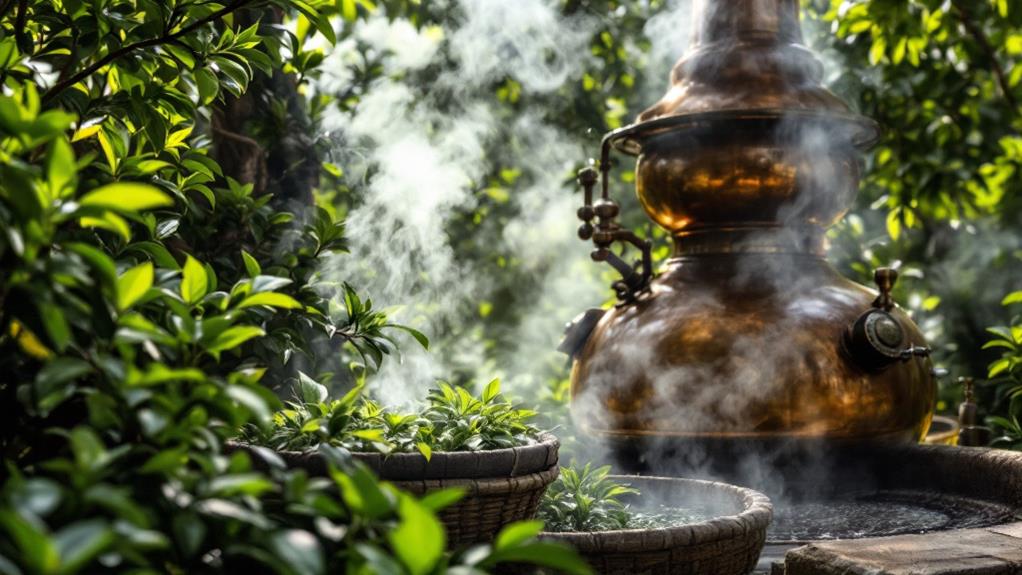
Extracting tea tree oil from the Melaleuca alternifolia plant involves a precise steam distillation process. This method vaporizes the important oil by passing steam through the plant's leaves and branches. As the steam travels through the plant material, it carries the vaporized tea tree oil to a condenser. There, the steam cools down, transforming back into a liquid state and allowing the oil to separate from water and other components. The oil yield from this extraction process typically ranges from 1% to 2% of the plant's wet weight, making it imperative to optimize the distillation process for maximum efficiency.
International standards regulate the chemical composition of tea tree oil, particularly focusing on the levels of terpinen-4-ol, to guarantee its quality and effectiveness as an important oil. These standards help maintain consistency across batches, which is significant for both consumers and producers. Once extracted, proper storage of the tea tree oil is critical. You need to keep it in dark, cool, and dry conditions to prevent degradation. This careful storage maintains the integrity of its chemical composition, guaranteeing the oil remains potent and effective for its intended uses.
Chemical Composition
Understanding the chemical composition of tea tree oil (TTO) is essential for appreciating its therapeutic properties. TTO is primarily made up of terpene hydrocarbons, featuring over 100 identified chemical components. Among these, monoterpenes play a significant role. The major active ingredient is terpinen-4-ol, which constitutes 30-40% of the oil and is renowned for its potent antimicrobial properties—11 times stronger than phenol. This makes terpinen-4-ol a key player in the oil's effectiveness.
Other notable elements in TTO include:
- 1,8-cineole: Approximately 4% of TTO, contributing to its overall efficacy.
- p-cymene: Present at 2-5%, adding to the oil's therapeutic value.
- α-terpinene: Comprises about 13%, enhancing TTO's properties.
International standards regulate TTO's chemical composition, guaranteeing quality by setting thresholds for these components. This regulation maintains the therapeutic properties you expect from tea tree oil. To preserve TTO's chemical integrity, proper storage conditions are essential. Keep it in a dark, cool, and dry place, as exposure to light, heat, and moisture can alter its composition. By adhering to these guidelines, you'll ensure that your tea tree oil remains effective and beneficial.
Storage and Quality Control
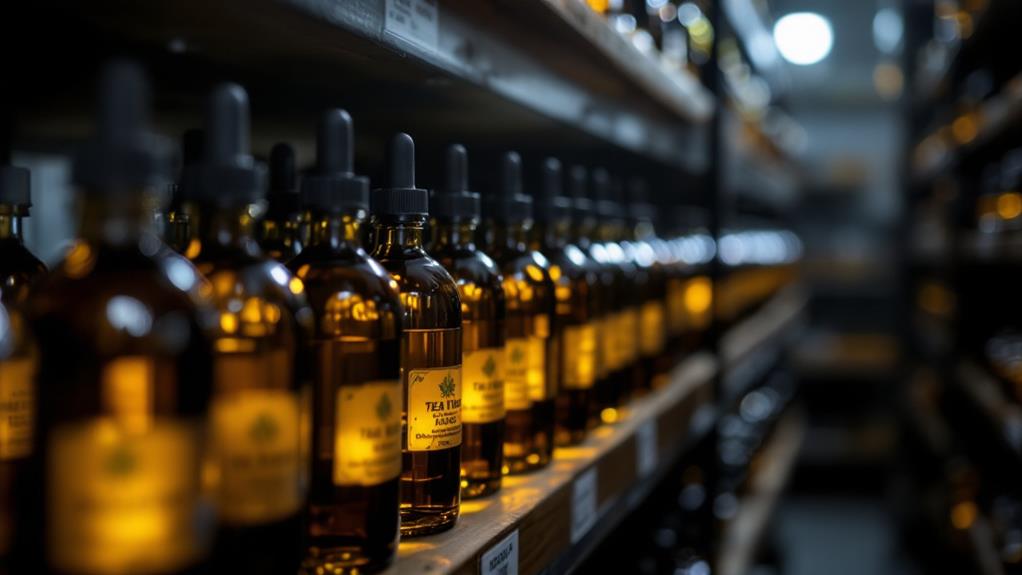
In regard to preserving the quality and effectiveness of tea tree oil (TTO), proper storage is fundamental. To maintain its composition and stability, you should store TTO in dark, cool, and dry conditions. Exposure to light, heat, and moisture can degrade the oil, compromising its efficacy. Using amber glass bottles is a smart choice as they protect the oil from harmful light exposure, guaranteeing its properties remain intact.
Quality control of TTO is significant and governed by international standards. These standards focus on guaranteeing the oil's composition includes the major active component, terpinen-4-ol, which is crucial for its antimicrobial activity. To verify this, chemical analyses are performed, evaluating the concentration of key components and identifying any impurities that could affect the oil's performance.
When stored correctly, TTO generally has a shelf life of up to two years. During this time, regular checks on the oil's quality through chemical analyses can help confirm it maintains its intended benefits. By adhering to these storage guidelines and quality control measures, you can guarantee that the tea tree oil you use remains effective and safe throughout its shelf life.
Traditional Uses
Tea tree oil, a multifunctional remedy, has long been valued for its healing properties by the Aboriginal peoples of Australia. They traditionally used this potent oil for its impressive ability to tackle numerous health issues. Among its many uses, tea tree oil was particularly effective in treating coughs, colds, and skin ailments. The Bundjalung Aboriginal peoples employed tea tree leaves in herbal remedies. They even utilized inhalation methods to address respiratory infections, showcasing the oil's multifaceted benefits.
The documented medicinal properties of tea tree oil came to light in the 1920s when chemist Arthur Penfold recognized its potential as a germicide. This revelation led to a broader acknowledgment of its antimicrobial efficacy, especially noted in the initial official report in 1930. These findings contributed to tea tree oil's popularity in alternative medicine.
Here's a quick recap of its traditional uses:
- Treatment of respiratory infections: Utilizing inhalation methods with tea tree leaves.
- Skin ailments: Alleviating conditions through its antimicrobial properties.
- Herbal remedies: Incorporating it in numerous traditional preparations.
Over time, these uses evolved, paving the way for its inclusion in modern skincare products like acne treatments and wound care.
Modern Applications

Today's assorted uses of tea tree oil (TTO) underscore its enduring value, particularly highlighting its antimicrobial capabilities. Thanks to its active component, terpinen-4-ol, TTO is a go-to remedy for acne and differing skin infections. It's a staple in many skincare routines, tackling stubborn breakouts and soothing inflamed skin. In hair care, TTO's prowess continues, where shampoos and conditioners harness its benefits to combat dandruff and promote scalp health, especially with a 5% concentration showing significant improvements.
But TTO's usefulness doesn't stop at personal care. It's a natural disinfectant in household cleaning products, effectively targeting bacteria, fungi, and viruses, which makes it an eco-friendly alternative to harsh chemicals. In oral care, TTO plays a role in reducing gingivitis and bad breath, though you should be cautious about ingestion due to potential toxicity.
The cosmetic industry also adopts TTO for its anti-inflammatory effects, crafting products that appeal to those wanting natural solutions over synthetic ones. Understanding the extraction process of TTO not only reveals its adaptability but also reassures you about its natural origin, making it a cherished component in modern applications.

